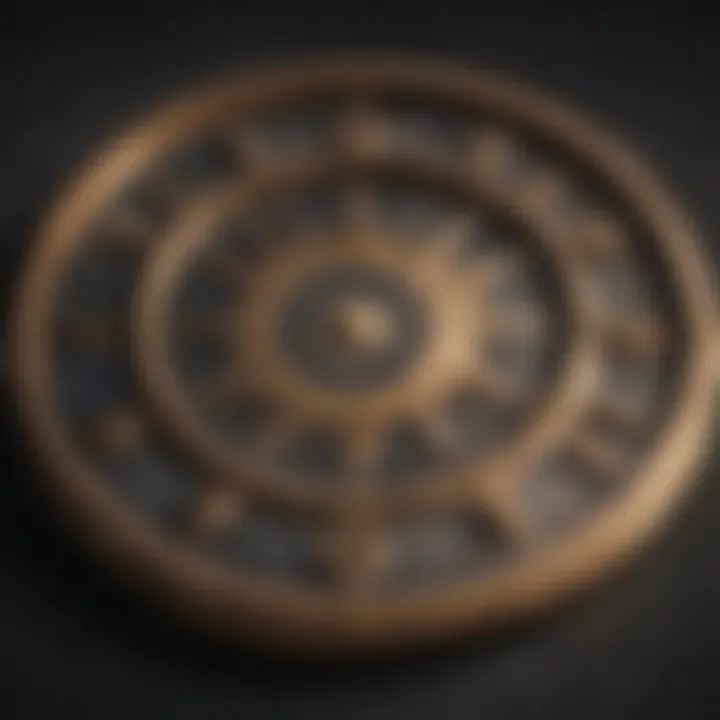Deciphering Your Zodiac Chart: A Complete Guide


Intro
Astrology offers a fascinating lens through which many people interpret their lives. The zodiac chart stands at the heart of this practice, much like a roadmap guiding one’s journey through personal experiences. From intimate relationships to career paths, the intricate dance of celestial bodies at the time of one’s birth provides profound insights. But delving into these nuances can feel like deciphering an ancient script; fear not, for this guide is dedicated to illuminating the fog that often clouds our understanding of zodiac charts.
In the sections that follow, we’ll explore the various components of these astrological blueprints—planets, houses, and aspects. Each plays a crucial role in weaving the tapestry of our existence. Understanding the zodiac involves more than just knowing your sun sign; it’s a layered approach that reveals strengths, challenges, and the unique narrative of each individual.
Understanding the essential elements of a zodiac chart can help illuminate personality traits, influence decisions, and enhance self-awareness.
Let’s embark on this journey together, exploring the depths of your chart and discovering what the cosmos has to say about you.
Understanding the Zodiac
Overview of Zodiac Signs
The zodiac comprises twelve distinct signs, each symbolizing unique characteristics and energies. These signs are categorized into four elements—fire, earth, air, and water. Each element, in turn, showcases distinct traits:
- Fire Signs (Aries, Leo, Sagittarius): Embody passion, courage, and energy.
- Earth Signs (Taurus, Virgo, Capricorn): Known for their practicality, stability, and groundedness.
- Air Signs (Gemini, Libra, Aquarius): Characterized by intellect, communication, and sociability.
- Water Signs (Cancer, Scorpio, Pisces): Associated with emotions, intuition, and sensitivity.
These elements act as the foundation for understanding how signs interact with each other. But knowing the elements alone isn’t enough; there’s more depth to be mined from the individual signs.
Sign Traits and Characteristics
Each zodiac sign exhibits a range of traits—some uplifting, others perhaps a little more challenging. For instance, while a Leo might be marked by charisma and an innate desire to be in the spotlight, they might also wrestle with stubbornness and pride. On the other hand, Pisces, empathetic and imaginative, may sometimes find themselves lost in dreams, struggling with reality.
A brief overview of each sign:
- Aries: Bold, adventurous, and sometimes impulsive.
- Taurus: Patient, reliable but can be overly possessive.
- Gemini: Curious and adaptable, yet restlessness is common.
- Cancer: Sensitive and nurturing, but can retreat into their shell.
- Leo: Proud leaders with a generous heart, yet may crave validation.
- Virgo: Detail-oriented and analytical, sometimes overly critical.
- Libra: Diplomatic and charming, but prone to indecision.
- Scorpio: Intense and magnetic, yet secretive to a fault.
- Sagittarius: Free-spirited, philosophical but can lack direction.
- Capricorn: Disciplined and ambitious, though may seem aloof.
- Aquarius: Innovative and unconventional, often coming off as detached.
- Pisces: Compassionate and artistic, but frequently escapist.
Elemental Qualities
Deepening our understanding of these signs further involves exploring their elemental qualities. Each element imparts specific attributes to its associated signs. Fire signs often thrive on expressiveness and enthusiasm, earth signs prioritize stability, air signs dwell in conversation and mental stimulation, while water signs navigate the emotional realm. This elemental differentiation shapes interpersonal dynamics and self-awareness deeply.
"A person’s character oftens shines brightest under the strain of opposing elements."
Understanding the elemental mixture within one’s chart can provide deeper insights into emotional responses and decision-making styles.
In the upcoming sections, we will delve into astrological insights that consider how current trends and celestial events influence your personal zodiac narrative.
Foundations of Astrology
Astrology, often viewed as an intricate tapestry woven from celestial threads, serves as the bedrock upon which the entire discipline rests. Understanding the Foundations of Astrology is pivotal for anyone wishing to decode their zodiac chart. This section shines a light on the historical, philosophical, and practical aspects of astrology, helping to equip readers with the knowledge needed to parse through their charts with clarity.
Astrology is not a mere set of symbols floating in the ether; it embodies centuries of human observation, beliefs, and culture. Its importance lies in how it allows individuals to connect the dots between celestial movements and earthly experiences. Such an understanding can lead to profound personal insights as well as facilitate personal growth.
Historical Overview of Astrology
The historical evolution of astrology marks it as one of the oldest forms of knowledge known to humanity. Rooted deep in ancient civilizations, traces of astrological practices can be found among the Greeks, Babylonians, and Egyptians, among others. Each civilization contributed significantly to astrological frameworks, contemplating celestial bodies and their impacts on earthly affairs.
Astrology began as a means of predicting seasonal changes, aiding in agriculture and harvests. Over centuries, it morphed into a systematic framework where the movements of planets and stars became correlated with human destinies.
Astrologers from yore were skilled observers, carefully recording planetary alignments. This meticulous attention established a wealth of knowledge that continues to shape astrological practices to this day. From the Hellenistic Period to the Renaissance, astrology intersected with philosophy, spirituality, and science, inviting discussions that are still relevant.
"Astrology is a language. If you understand this language, the sky speaks to you." – Dane Rudhyar
The Role of Zodiac Signs
Zodiac signs are like the chapters in a book, each one written with its own unique narrative, influences, and characteristics. There are twelve signs, each corresponding to specific traits that can be used to understand individual personalities and behaviors.
The zodiac belt, divided into twelve equal segments, is an essential component of every astrological chart, corresponding to the sun's path throughout the year. Within this framework, each sign brings a distinct energy and flavor, contributing to the greater astrological narrative.
- Aries – Represents action, courage, and enthusiasm.
- Taurus – Symbolizes stability, patience, and determination.
- Gemini – Reflects curiosity, adaptability, and communication skills.
The significance of zodiac signs lies not just in their inherent characteristics but also in their ability to interact with the motions of planets and the configurations of houses within an astrological chart. Each sign functions like a lens through which celestial energies manifest, guiding individuals in reflecting upon their emotions, decisions, and interactions. Understanding these signs shapes one’s existential journey, unveiling deeper insights into oneself and one's surroundings.
Components of a Zodiac Chart
Understanding the components of a zodiac chart is akin to grasping the blueprint of a building before it rises. Each element within the chart contributes its own layer to the intricate structure of astrological interpretation. By exploring these components—birth chart, planets, houses, and their relationships—one can extract meaningful insights into their personality and life experiences. The importance of this section lies in establishing a solid foundation for comprehending how various forces interplay within one's astrological makeup.
Defining the Birth Chart


The birth chart, or natal chart, is basically a snapshot of the sky at the precise moment you took your first breath. More than just dots in the sky, it showcases the positioning of celestial bodies, capturing their influence on your life. Knowing the location of the Sun, Moon, and planets during your birth offers vital clues about your innate traits, challenges, and talents.
To truly define a birth chart, you’ll want to look at three core components:
- Zodiac Signs: Each planet resides in a specific sign, dictating how its energy expresses itself. For example, someone with Venus in Libra might have a strong inclination towards harmony and relationships.
- Houses: The wheel of your chart is divided into twelve houses, representing different areas of your life like career, relationships, and home. Where a planet resides indicates where its influence will be felt most.
- Aspects: These are the angles formed between planets, revealing how they interact with one another—whether in harmony or conflict.
Together, these elements forge a unique perspective that shapes your personality, offering insights that go far beyond mere sun signs.
Understanding the Planets
Planets are the actors that drive the cosmic play of your life. They symbolize various facets of your being, each playing a distinct role. Here’s a quick rundown of the primary planets and what they represent:
- Sun: The essence of who you are, your core identity.
- Moon: Your emotions, instincts, and inner self.
- Mercury: Communication and intellect.
- Venus: Love, beauty, and relationships.
- Mars: Action, drive, and aggression.
- Jupiter: Growth, luck, and philosophy.
- Saturn: Structure, discipline, and challenges.
- Uranus, Neptune, Pluto: Generational influences that shape broader societal trends.
Each planet’s position in a sign and house delineates how these energies manifest. It's vital to consider both the zodiac sign and house each planet occupies in your birth chart, as this will fine-tune the understanding of how their characteristics play out in your life.
The Twelve Houses Explained
The twelve houses are like various rooms in a sprawling mansion, each serving a different purpose and hosting a different set of activities. They provide context to the energies represented by the planets.
Here is a brief overview of what each house typically governs:
- First House: Self and identity.
- Second House: Finances and values.
- Third House: Communication and immediate environment.
- Fourth House: Home and family life.
- Fifth House: Creativity and romance.
- Sixth House: Health and daily routines.
- Seventh House: Partnerships and marriage.
- Eighth House: Transformation and shared resources.
- Ninth House: Philosophy, higher learning, and travel.
- Tenth House: Career and public image.
- Eleventh House: Friendships and community.
- Twelfth House: Subconscious and hidden matters.
Understanding where the planets reside in these houses can reveal much about your motivations, challenges, and areas of growth.
Remember: The zodiac chart is not just a map; it’s a multi-dimensional experience that adds layers to your understanding of self.
By familiarizing yourself with these components, you lay the groundwork for deeper explorations into the complex world of astrology.
Interpreting Zodiac Signs
Understanding how to interpret zodiac signs is a fundamental aspect of astrology. This process allows individuals to make connections between celestial patterns and their own lives. At its core, the interpretation of zodiac signs offers profound insights into personality traits, emotional responses, and relational dynamics. Being aware of these signs can help folks align their actions with their nature or even challenge them to grow.
Personalities are often interconnected with the characteristics of their zodiac sign. The signs reflect a spectrum of behavioral tendencies, which can provide clues to how one might react in various situations. It's essential to recognize that everyone is unique, despite the generalized traits associated with each zodiac sign. Therefore, gaining clarity into zodiac signs serves as a springboard for deeper personal exploration and growth.
Characteristics of Each Sign
Each zodiac sign is steeped in rich characteristics that color individual behavior and mindset. Here’s a look at what defines the twelve signs:
- Aries (March 21 - April 19): Energetic and courageous, they are known for their spirited leadership but can be impulsive.
- Taurus (April 20 - May 20): Stability and reliability are their signatures. They appreciate the finer things in life, yet can be quite stubborn.
- Gemini (May 21 - June 20): Social butterflies, their adaptability and intellect shine. However, their duality can complicate things.
- Cancer (June 21 - July 22): Emotional and nurturing, they prioritize family yet may retreat into their shells during tough times.
- Leo (July 23 - August 22): Heralded as vibrant and passionate, they thrive on admiration, but arrogance can rear its head.
- Virgo (August 23 - September 22): Detail-oriented and analytical, they are methodical in their approach, which can come off as critical.
- Libra (September 23 - October 22): Lovers of harmony, they seek balance in relationships but may struggle with indecision.
- Scorpio (October 23 - November 21): Passionate and intense, their depths are mysterious. They value loyalty, yet jealousy can be a downfall.
- Sagittarius (November 22 - December 21): Adventurous souls with philosophical minds, they seek truth but can be blunt.
- Capricorn (December 22 - January 19): Ambitious and disciplined, they work tirelessly toward goals, often delaying gratification.
- Aquarius (January 20 - February 18): Innovators with a love for freedom, they cherish individuality, but can seem detached.
- Pisces (February 19 - March 20): Idealistic and empathetic, they are sensitive souls, often lost in their dreams.
Recognizing these distinctions aids in understanding not just yourself but also those around you. Life becomes a little clearer when we acknowledge the myriad qualities associated with each sign.
Common Misconceptions about Zodiac Signs
As with any field, astrology is rife with misconceptions that can cloud understanding of zodiac signs. Here are a few common fallacies that deserve clarification:
- Zodiac Signs Determine Fate: Many believe that their sign dictates their entire life path. While they might reflect tendencies, it doesn't seal one's destiny.
- Compatibility is Black and White: There’s a general belief that certain signs clash while others mesh seamlessly. Relationships are more nuanced and should not be determined solely by signs.
- Zodiac Signs Are Static: Some think their traits cannot evolve. In reality, personal growth and experiences can influence one's zodiac attributes over time.
- All Geminis are Two-Faced: The notion that Geminis have dual personalities can be misleading. Duality can actually signify adaptability, not deception.
- Astrology is Just For Women: The stereotype that astrology is a feminine domain oversimplifies the topic and ignores its universal appeal.
“Understanding the myths around zodiac signs can help individuals to better navigate their personal and relational landscapes.”
By untangling these misconceptions, readers can develop a more nuanced understanding of how zodiac signs influence behavior, improving not just self-awareness but also interpersonal dynamics.
In summary, interpreting zodiac signs is far from an intellectual exercise; it’s an engaging exploration of the self and relationships with others. By embracing both the strengths and weaknesses presented by each sign, individuals can foster a deeper comprehension of their choices and the world around them.
The Importance of Elements and Modalities
Understanding elements and modalities in astrology is essential for decoding the intricacies of a zodiac chart. These foundational concepts act as the building blocks of astrological interpretation, influencing personal characteristics, natural tendencies, and interpersonal dynamics. Each element and modality conveys a distinct energy that shapes how a person interacts with the world. Ignoring these aspects can lead to a superficial reading, missing the profound insights that lie beneath the surface of a chart.
In astrology, elements refer to the four essential categories: Fire, Earth, Air, and Water. Modalities, on the other hand, denote the three modes of expression: Cardinal, Fixed, and Mutable. Together, these components create a rich tapestry that highlights how individuals behave, respond to challenges, and form relationships, providing an intricate framework for detailed analysis.
Fire, Earth, Air, and Water Signs
Each element embodies unique characteristics that define its signs. Fire signs (Aries, Leo, Sagittarius) are known for their passion and enthusiasm. They tend to be bold and spontaneous, often charging forward into the fray. These signs are all about action, exuding warmth and a lust for life that drives their desire for adventure.
Earth signs (Taurus, Virgo, Capricorn), on the other hand, ground individuals, bringing a practical and stable perspective. They are reliable, down-to-earth, and often seek security in their lives. With their steadfast nature, Earth signs excel in creating order and value in a chaotic world.
Air signs (Gemini, Libra, Aquarius) are social beings, driven by intellectual curiosity and a love for communication. They thrive on ideas and concepts, often becoming the progressive thinkers among their peers. Flexibility defines them, adapting to shifting scenarios and fluid thoughts with grace.


Lastly, Water signs (Cancer, Scorpio, Pisces) are deeply emotional and intuitive. They are empathetic, understanding, and connect strongly to their feelings and the feelings of others. Often marked by depth, sentimentality, and imagination, these signs navigate the ebb and flow of emotions in ways that many other signs may not.
Cardinal, Fixed, and Mutable Modalities
Modalities further refine the expression of these elements. Cardinal modalities (Aries, Cancer, Libra, Capricorn) represent initiation and action. They are born leaders, possessing the drive to create change and new beginnings. This mode pushes individuals to get things started, often taking risks that others may shy away from.
Conversely, Fixed modalities (Taurus, Leo, Scorpio, Aquarius) embody stability and determination. These signs are trustworthy and resilient, tending to hold onto their beliefs and plans with a firm grip. They provide a necessary anchor, resisting fluctuation and remaining unwavering amidst upheaval.
Mutable modalities (Gemini, Virgo, Sagittarius, Pisces) showcase adaptability and versatility. These signs excel at going with the flow and handling change, demonstrating an ability to pivot when circumstances shift. They're the ones who can find solutions in unexpected situations, reshaping their responses based on evolving scenarios.
The interplay between elements and modalities enriches the interpretation of each sign, allowing astrologers to paint a more nuanced picture of a person's astrological landscape.
End
In summary, the importance of elements and modalities in astrology cannot be overstated. They form the essential framework upon which personal traits and behaviors are built. By delving into these aspects, astrologers are better equipped to understand the intricacies of a person's zodiac chart. When combined, elements and modalities create a holistic view of personality and relationship dynamics, leading to deeper insights and a more profound comprehension of oneself and others.
Aspects in Astrology
Aspects in astrology are vital for understanding how various astrological elements interact with one another. They provide a deeper insight into the dynamics of a person’s chart, creating a layer of complexity that goes beyond the surface-level interpretation of individual planets and signs. Essentially, aspects describe the relationships between the planets based on their distances from each other, and these relationships can greatly influence how their respective energies manifest in a person's life.
By examining aspects, you can get a sense of tension, harmony, or challenges present in the chart—insights that are crucial for anyone interested in astrology. Understanding aspects allows you to read a chart not only as a collection of signs and planets but as an interconnected web of influences that shape an individual’s experiences and personality traits.
There are three primary categories of aspects: major aspects, which include conjunctions, sextiles, squares, trines, and oppositions; minor aspects, which include quincunxes, semi-squares, and sesquiquadrates; and orb, the margin of error within which an aspect is considered significant. The more you familiarize yourself with aspects, the clearer the unique patterns in your zodiac chart will become.
"Aspects serve as the secret language of the cosmos, revealing hidden truths about our nature and our paths."
Major Aspects and Their Significance
The major aspects are the backbone of astrological interpretation. Each one carries its own unique energy and significance, affecting how planets influence a person's life and personality. Here’s a quick look at each major aspect:
- Conjunction (0°): Occurs when two planets are within a few degrees of each other, blending their energies. This aspect often amplifies the influence of both planets, leading to significant effects in a person's chart.
- Sextile (60°): A harmonious aspect that fosters opportunities and positive interactions between two planets. This aspect encourages growth and development, making it easier for energy to flow between the two influences.
- Square (90°): Often considered a challenging aspect, squares create tension and conflict. They can lead to growth through struggle, pushing individuals to confront their inner conflicts and seek resolution.
- Trine (120°): This is a supportive aspect, allowing for easy integration and harmony between planets. Trines can indicate talents and gifts that come naturally, often manifesting without much effort.
- Opposition (180°): This aspect represents a push-pull dynamic between two planets, often highlighting the need for balance and compromise. It can signify external challenges or conflicts that draw attention to the need for integration.
Understanding these aspects can significantly deepen one’s astrological practice, allowing practitioners to see beyond the individual planetary placements and narratives within a chart.
How Aspects Influence Personal Dynamics
Aspects impact personal dynamics in numerous ways, shaping how individuals interact with the world and those around them. For example, if two planets are in a square aspect to one another, a person may experience inner conflict associated with those planets’ energies. This could manifest as difficulties in decision-making or a propensity to feel torn between competing desires.
On the other hand, strong supportive aspects, like trines, encourage positive relationships and ease in life’s endeavors. A person with a notable trine between their Sun and Moon may experience an inner harmony that supports their emotional and creative impulses.
When reading a chart, consider not just the planets involved but also the overall balance of aspects. Are there more harmonious interactions than challenging ones? Understanding the interplay among aspects can reveal insights about someone’s potential struggles, motivations, and strengths.
In summary, aspects play a crucial role in shaping personality and interpersonal dynamics. Recognizing how these relationships function within a zodiac chart can shed light on one's behavior, choices, and deeper psychological patterns, enriching the overall understanding of astrology.
The Art of Chart Synthesis
Understanding your zodiac chart isn't merely about piecing together individual components like planets, houses, or signs. It's about seeing the big picture. The Art of Chart Synthesis focuses on how these elements interact and weave together to create a coherent narrative of an individual's astrology. This synthesis can provide profound insights into one’s personality, motivations, and life roles.
Chart synthesis allows astrologers to interpret not just isolated characteristics but to see how they blend and influence each other, providing a rich, layered understanding of one's being. Instead of just a laundry list of traits, the synthesis reveals how a fiery Aries sun sign might interact with a gentle Libra moon, balancing assertiveness with diplomacy, for instance. The chart's whole becomes much more telling than the sum of its parts.
A methodical approach to synthesis can uncover contradictions and harmonies present in one's chart. For example, someone with a dominant earth element may possess practical, grounded tendencies, but a strong water presence might also suggest emotional depth! By analyzing these contrasts, astrologers gain insights into the challenges a person may face or the unique strengths they hold.
Bringing Together Chart Elements
When delving into chart synthesis, the first step is pulling together all the chart elements. Each planet, sign, and house carries distinct meanings and energies, but their true value emerges when we see how they relate to one another.
- Planets: Each planet symbolizes different aspects of human experience, like the drive of Mars or the emotional undercurrents of the Moon.
- Signs: The zodiac signs bring flavor to planetary energies, coloring them with specific attributes like Leo’s charisma or Capricorn’s determination.
- Houses: The twelve houses represent different life sectors—such as relationships or career—enriching our understanding of where energies manifest.
In the process of synthesis, look for aspects (the angle between planets) as they can significantly modify the impact of these elements. For example, a harmonious trine might blend energies beautifully, while a challenging square could hint at internal struggles or external conflicts.
"Astrology does not cause anything to happen to you; it merely offers potential variations of what can happen. Understand it, and you can navigate your choices insightfully."
The goal here is to create a narrative. For instance, if someone has a Virgo Sun in the seventh house while their Moon is in Aquarius in the eleventh house, you can suggest that relationships (seventh house) might serve the purpose of analyzing ideas or contributing to social causes (Aquarius) through teamwork (eleventh house).
The Importance of Context in Chart Reading
While synthesizing the elements of a zodiac chart is crucial, context is paramount. It's easy to get caught up in individual placements, but without considering the individual’s life circumstances—such as their environment, experiences, and relationships—the chart may remain an incomplete puzzle.
Context can come from:


- Life Experiences: Personal history, challenges, and achievements profoundly shape how energies are expressed. An individual with a challenging aspect in their chart might have adapted their behavior based on past experiences that add unique layers to their astrological narrative.
- Current Transits: The movement of planets can trigger different parts of the chart, bringing certain energies to the forefront during specific times. Being aware of these influences allows for a nuanced understanding of the potential outcomes.
- Cultural and Societal Factors: Astrology does not exist in a vacuum. The societal norms and cultural background of a person can greatly influence how they express their chart. This is particularly true in today's interconnected world.
When readers approach their zodiac chart synthesis, urging them to consider context adds one more layer of significance, allowing for a full-bodied interpretation that honors the complexities of human experience.
In summary, Mastering the Art of Chart Synthesis requires looking beyond individual components to grasp their interplay while being deeply attuned to the context surrounding an individual’s life. This way, one can truly appreciate the wisdom embedded in their zodiac chart.
Zodiac Charts and Personality
Understanding the influence of zodiac charts on personality is an essential piece of the astrological puzzle. Your chart acts like a cosmic footprint, revealing traits and tendencies that shape who you are. Each element in your chart tells a story that goes beyond basic characteristics; it unveils layers of depth that define your individual spirit. When we look at charts, we enter a realm where celestial positions influence every swipe of our personality.
Influence of Chart on Individual Traits
A person’s zodiac chart is like their personal guidebook, illustrating how celestial bodies influence their inherent traits.
- Sun Sign: Often regarded as the main character in your astrological play, the Sun sign reflects your core essence, ego, and overall identity. If you take a Leo, for instance, traits like confidence and warmth may shine brightly.
- Moon Sign: Diving deeper, the Moon sign highlights emotions and inner drives. A Cancer Moon typically indicates someone who feels deeply and may value family above most.
- Rising Sign (Ascendant): This sign acts as your social mask and shows how you're perceived by the world. A Pisces rising can often give the impression of being gentle, sensitive, and perhaps a little dreamy.
- Planetary Positions: Each planet's placement adds nuance. For example, Venus in Gemini might foster charm and sociability, indicating a preference for relationships built on communication.
- Elemental Composition: The balance of elements—fire, earth, air, and water—shapes your personality fabric, so a predominance of earth signs such as Taurus or Virgo can lead to practicality and a steady nature.
Through careful analysis of these components, one can begin to understand a person’s quirks, motivations, and stumbling blocks.
Exploring Relationship Dynamics through Charts
Zodiac charts not only define individual traits but also offer insightful perspectives on relationships. Astrological compatibility can often play a significant role in understanding how various signs interact with one another, providing deeper insights into the nature of connections.
- Synastry: This is the art of comparing two charts to see how they interact. By analyzing aspects between two people’s charts, you can uncover areas of harmony and friction, revealing why some relationships feel easier than others.
- Composite Chart: Another method is creating a chart that represents the relationship itself. This chart's characteristics can highlight the purpose and dynamics of the relationship, shedding light on challenges and strengths.
- House Overlays: Look at where someone's planets fall in your chart. If someone’s Venus, for example, falls into your seventh house of partnership, their expression of love may bring significant value into your life.
- Elemental Matches: Fire signs often match well with air, as they fuel each other's creativity, while earth and water can nurture a profound emotional connection. Recognizing these elemental dynamics can pave the way for meaningful connections.
In a nutshell, zodiac charts create a framework, guiding you through the complex abilities of human connection. This understanding not only enhances your interpersonal relationships but also fosters a greater sense of self-awareness.
Advanced Chart Analysis
Understanding an astrological chart goes far beyond just knowing your sun sign. In fact, the practice of Advanced Chart Analysis provides a window into the dynamic interplay of various celestial influences as they affect your life. This approach offers deeper insights into your personal experiences, showcasing how transits and progressions shape who you are, your relationships, and your journey.
Transits and Their Impact
Transits refer to the movements of planets as they travel through the sky. These movements, relative to your birth chart, hold significant weight in predictive astrology. Think of transits as a dance between the cosmos and your individual energy. For instance, when Jupiter transits your fifth house, it often heralds a time for personal growth and expansion in areas like creativity or romance.
Notably, the impacts of these transits can vary dramatically, not just depending on the planet's nature but also on the houses they move through. For example:
- Inner Planets (like Mercury and Venus) may trigger quick changes or shifts in daily life.
- Outer Planets (like Saturn or Pluto) bring more profound, long-term challenges or transformations.
Moreover, the aspects created during a transit—be it conjunctions, squares, or trines—further influence the overall energy, making it crucial to consider how energies blend or clash. Consider this: If Mars aligns with your Moon during a transit, you may feel a surge of assertiveness impacting your emotional life. This can lead to productive outcomes or heated exchanges, depending on how you navigate the energy.
It's worthwhile to pay attention to recurring themes or patterns; these often highlight what the universe is trying to communicate. One thing’s for sure: navigating your life’s roadmap becomes clearer once you recognize the currents of celestial flow.
Progressions and Their Meaning
In astrology, progressions take a more personal tune as they evolve from the static positions of your natal chart. The technique often involves a symbolic method, where each day after your birth corresponds to a year of your life; thus, if you're analyzing your third year, you'd look at what the sky looked like three days post-birth.
With progressions, one can see how the energy of planets shifts, revealing the unfolding story of your personal development. For instance:
- A progressing Sun into a new sign signifies a powerful phase of identity reshaping—perhaps it’s time to take stock of your personal aspirations or career goals.
- When Saturn progresses forward, it often invites moments of solemn reflection and responsibility, marking significant life transitions.
The resonance of progressions can manifest in tangible changes: career shifts, relational dynamics, and personal insights. The beauty lies in their potential; while a transit may affect what is happening in your life, progressions show how you are changing internally.
Ultimately, both transits and progressions work hand in hand. They offer us vital clues and guidance on our journey of self-discovery and personal evolution. Considering both elements can yield a comprehensive view of what the stars currently dictate and how they align with your evolving essence.
"Astrology is not about fate; it’s about the choices we make influenced by the cosmic energies around us."
With a thorough exploration of transits and progressions, you don’t just learn how to interpret charts—you become equipped to grasp the intricate layers of your unique life story, allowing you to steer your personal ship more consciously through the waves of existence.
Practical Tips for Readers
Understanding your zodiac chart is not just an academic exercise; it’s a personal journey which can truly enhance your daily existence. It arms you with insights that can inform decisions, lighten your relationships, and even guide you through challenges. This section sums up practical strategies that readers can incorporate into their everyday lives. Doing so can help you apply astrological concepts in a tangible way, leading to a more enriched experience.
Utilizing Astrology in Daily Life
Integrating astrology into your daily life isn’t as daunting as it may seem. Here are a few helpful pointers to get you started:
- Daily Moon Phases: Know which phase the moon is currently in. For instance, during a new moon, people often focus on new beginnings and setting intentions, while the full moon can be a time for reflection and letting go.
- Chart Cycle Awareness: Familiarize yourself with the current positions of planets with respect to your natal chart. For example, if Jupiter is in your tenth house, it might be an ideal time for career advancements or taking on new professional challenges.
- Personal Reflection: Try journaling based on astrological transits. When Mercury retrogrades, note your communication errors or misunderstandings. This can help you see patterns and understand how celestial movements affect your life.
- Date Selection for Events: Use your understanding of astrological aspects to pick auspicious dates for meetings, projects, or even personal matters like weddings. Favorable planetary alignments can significantly influence outcomes.
To make the most of these strategies, it's also essential to remain flexible. Astrology offers guidance, but it won't replace your free will. Expect to adapt as new insights arise.
Resources for Further Exploration
Knowledge about zodiac charts and astrology is vast and ever-evolving. To deepen your understanding further, seek out the following resources:
- Books and Literature: Check out titles like "The Only Astrology Book You'll Ever Need" by Joanna Martine Woolfolk or "Astrology for the Soul" by Jan Spiller for foundational and advanced concepts.
- Online Forums: Join communities on forums such as reddit.com or facebook.com to connect with fellow enthusiasts. Engaging with others can help clarify your own thoughts and encourage new perspectives.
- Astrology Websites: Sites like en.wikipedia.org provide a treasure trove of articles on astrology. Meanwhile, britannica.com offers comprehensive overviews of specific astrological methodologies.
- Courses and Workshops: Many astrologers and esotericists also conduct online courses. Participating in these can offer live feedback which books can’t always provide.
Take time to evaluate which resources resonate with you most. Everyone’s journey in astrology is unique, and the right tools for one individual may not be suitable for another. Engage actively and critically with the materials you choose to explore.







